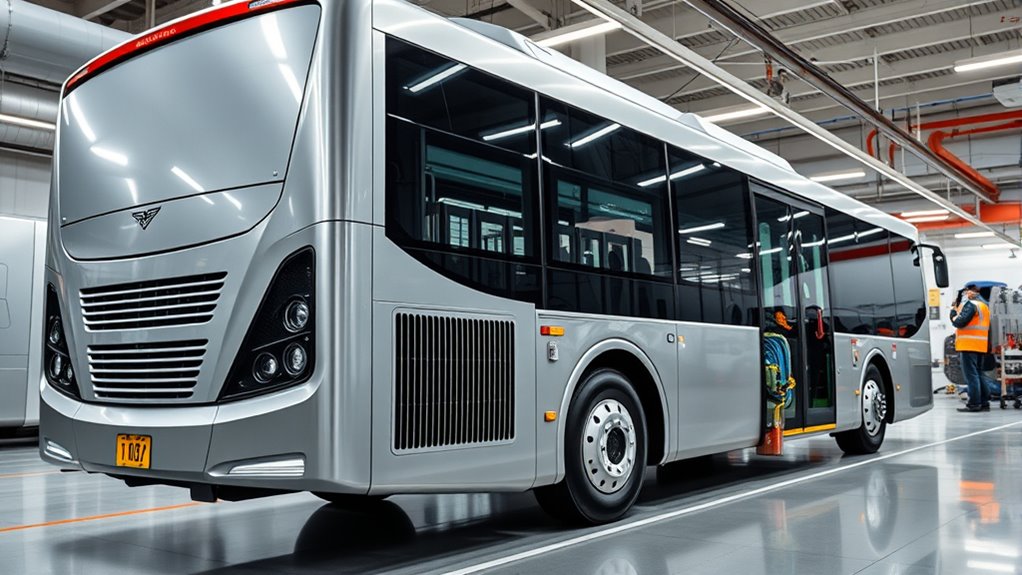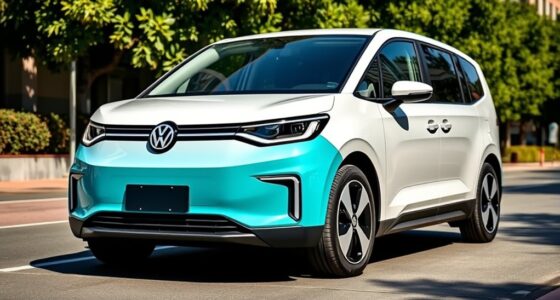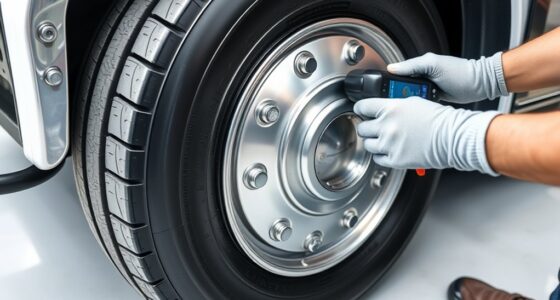Thermal management in electric buses is crucial for keeping your vehicle’s batteries and systems running smoothly and safely. Proper cooling and heating ensure batteries perform efficiently, last longer, and avoid overheating or freezing, especially in extreme weather. This keeps passengers comfortable and protects your investment from costly repairs. As technology advances, smarter and more compact thermal solutions improve overall performance. If you want to understand how these systems work together to boost reliability, keep exploring this essential topic.
Key Takeaways
- Proper thermal management maintains battery performance and extends lifespan by keeping temperatures within optimal 50-65°F range.
- It prevents overheating or freezing, reducing risks of battery failure and ensuring vehicle safety and reliability.
- Efficient thermal systems improve overall energy efficiency, lowering operational costs and supporting sustainable transit.
- Precise temperature control enhances passenger comfort and health in various climate conditions.
- Scalable and smart thermal management solutions enable adaptability for different bus models and future technological advancements.

Effective thermal management is essential for electric buses to operate efficiently, guarantee passenger comfort, and extend battery life. When you’re behind the wheel or riding as a passenger, you mightn’t realize how crucial these systems are. The core components of an electric thermal management (eTM) system include heat pumps, heat exchangers, and high-voltage heaters, all working together to maintain optimal temperatures.
These systems serve two main purposes: ensuring passengers stay comfortable and keeping the batteries at the right temperature for peak performance. As electric buses become more popular, integrating air conditioning with battery cooling has become a standard innovation, boosting overall efficiency and enhancing rider experience. Whether it’s a city bus or a school bus, these systems are adaptable, providing benefits across various vehicle types.
Thermal systems enhance comfort and efficiency across all electric bus types, from city to school buses.
Battery thermal management is especially vital because batteries operate best within specific temperature ranges—typically between 50 and 65°F. If temperatures go outside this window, performance drops, and battery lifespan diminishes. To prevent this, cooling systems often rely on water or glycol solutions that circulate through heat exchangers, effectively removing excess heat. Additionally, advances in thermal regulation are enhancing the precision and responsiveness of these cooling methods, leading to more reliable vehicle operation. Incorporating real-time monitoring technologies further optimizes temperature control by enabling immediate adjustments based on operating conditions.
In cold climates, PTC heaters kick in to warm batteries, ensuring they reach the ideal temperature quickly. The design of these systems includes compressors and heat exchangers to optimize cooling efficiency, all while minimizing energy waste. This precise temperature control not only extends battery life but also ensures the vehicle performs reliably under various conditions.
Efficiency is a major advantage of modern thermal management systems. Advanced air conditioning technology combined with heat recovery techniques reduces energy consumption, which directly translates to lower operational costs. Integrated designs are space-efficient, fitting comfortably within the bus’s structure without sacrificing passenger or cargo space.
These systems are also highly reliable, with fewer component failures due to their streamlined integration. When you consider the broader picture, this means fewer maintenance issues and longer intervals between repairs, helping transit agencies save money over time. The use of predictive maintenance powered by smart monitoring further enhances their dependability.
Passenger comfort and safety are central to thermal management. Maintaining consistent temperatures makes the ride more pleasant, especially during extreme weather. Precise climate control systems help improve passenger health and well-being by providing a stable environment.
Additionally, temperature regulation supports safe operation by preventing battery overheating or freezing, reducing the risk of failures or accidents. Covering a temperature range from -40 to +50°C, these systems can handle various climates, with cooling capacities reaching up to 42 kW and optional heating systems for cold regions.
Their flexible mounting options—roof, side, or rear—allow for easy installation on different bus models, while control systems operate smoothly on low-voltage DC power. As electric buses evolve, modular and scalable thermal management solutions will continue to improve. Incorporating smart system features further enhances efficiency and allows for real-time monitoring and adjustments, ensuring optimal operation at all times.
These adaptable systems can be customized to fit different bus sizes and climate conditions, integrating multiple components for a comprehensive approach. This scalability ensures that future models can meet increasing demands for efficiency, comfort, and safety.
In short, effective thermal management isn’t just a technical feature; it’s a crucial component that ensures electric buses deliver reliable, safe, and comfortable transportation now and in the future.
Frequently Asked Questions
How Does Thermal Management Affect Battery Lifespan?
Thermal management directly impacts your battery’s lifespan by keeping it within the ideal temperature range. When temperatures stay balanced, chemical reactions happen smoothly, reducing wear and tear.
If your battery overheats or gets too cold, it ages faster and loses capacity. Effective thermal management prevents thermal stress and runaway, helping your battery last longer and perform reliably over time.
Proper temperature control is key to maximizing your battery’s durability and safety.
What Are the Latest Cooling Technologies for Electric Buses?
You might think traditional cooling methods are enough, but recent innovations prove otherwise. The latest technologies, like Webasto’s scalable eTM system, combine high-capacity cooling with energy efficiency, integrating battery and cabin cooling seamlessly.
Environmentally friendly coolants and advanced air filtration improve sustainability and passenger comfort.
Compact, flexible designs with smart control systems guarantee reliable performance in extreme conditions, making these new cooling solutions more effective, durable, and eco-friendly than ever before.
How Do Climate Conditions Impact Thermal Management Strategies?
Climate conditions directly impact your thermal management strategies by influencing battery and cabin temperature control.
Cold weather demands more energy to keep batteries warm, reducing range and increasing charging times.
Conversely, hot climates require cooling systems to prevent overheating.
You need adaptable thermal systems like preconditioning and advanced heating or cooling technologies to maintain ideal temperatures, ensuring your bus performs efficiently regardless of external weather conditions.
What Maintenance Is Required for Thermal Systems?
You need to regularly inspect and maintain your thermal systems to keep everything running smoothly. Check cooling fluids, replace filters, and look for leaks in cooling lines. Guarantee electrical connections are secure, and verify sensor accuracy.
Service air conditioning units and clean heat exchangers regularly. Following safety protocols and monitoring energy use help prevent failures.
Proper maintenance enhances system efficiency, prolongs component life, and keeps passengers comfortable and safe.
How Does Thermal Management Influence Charging Efficiency?
You should know that thermal management directly impacts how efficiently your electric bus charges. When the battery stays within its prime temperature range, it absorbs energy faster, reducing charging times.
Active cooling systems help maintain this temperature, especially in extreme weather. By keeping batteries at ideal temperatures, your bus charges more predictably, conserves energy, and extends battery life.
This makes your fleet operations more reliable and cost-effective.
Conclusion
You might think thermal management is just a technical detail, but it’s actually the heart of electric bus performance. Proper cooling keeps batteries safe and efficient, extending their lifespan. Some say advanced thermal systems could even revolutionize electric transportation, making buses more reliable and eco-friendly. So, next time you see an electric bus, remember that behind the scenes, smart thermal management keeps it running smoothly, proving that a little heat control can make a big difference.









